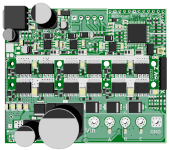Botvink
1 mW
- Joined
- Jan 26, 2023
- Messages
- 18
Hello friends,
I'm very new to the forum, but I wanted to contribute a little and share the project's changelog and get your valuable friends' ideas.
I design mostly brushed motor drivers, controllers for years and trying brushless motor designs, that design is my 4th attempt and at every update I changed.
Designed for max 6S lipo up to 200A current if possible, but first I plan for healthy 50A continous currents.

It is 4 layer board with NXP LFPAK88 mosfets and PSOC based controller. I will list items generally:

As it is low voltage driver I thought linear regulators can be enough. But it heats up quickly.. I guess I will change for next update.
As my aim is using at battle bots, combat robots which need full fast forward backward speeds, and high torques, sometimes up to stalls, I didn't planned to integrate FOC or sensorless control (though I don't have much knowledge about Foc.. )
)
Current sensor was ACS780 50A model. I planned to use higher current but out of stock. But while making tests with this current sensor It started to give faulty values and peak current signals as normally motor was driving at 3A, I read from console nearly 100A. I guess these ACS78x models are not suitable for inductive type forwars backward movements.. Some hall element inside broken or calibration broken..
So at next version I planned:
- Change Ground plane, traces with bigger, as it was my 1st 4 layer board, I didn't made power circulation well.
- Updating regulators (still my max voltage will be 6S lipo but it needs better ICs sure.
- Finding noise immune current sensor, Maybe ACS758?
- Top layer, power side will be unmasked.
I'm very new to the forum, but I wanted to contribute a little and share the project's changelog and get your valuable friends' ideas.
I design mostly brushed motor drivers, controllers for years and trying brushless motor designs, that design is my 4th attempt and at every update I changed.
Designed for max 6S lipo up to 200A current if possible, but first I plan for healthy 50A continous currents.

It is 4 layer board with NXP LFPAK88 mosfets and PSOC based controller. I will list items generally:
- Mosfet drivers are IRS21867 x 3, happy with them.
- Bootstrap diodes are SBRT3U45SAF-13 Super Barrier Rectifier, I had clues about shotky type or SBR diodes arebetter but used at controller and didn't see any much difference.
- Bootstrap capacitors are 2.2uF 100V X7R type.
- Controller is CY8C4245-AXI473, I choosed PSOC because I am only experienced on it, also using schematic design, Lookup tables, PWM blocks very easy.
- Mosfets are Buk7s1r0-40hj 40V 325A models with paralled x 2 for every channel.
- For 3 outputs I added MOV and TVS to power lines. also at main power line 1 x TVS added.
- 3 Temperature sensors added middle of mosfets. LM60BIM3 basic Sot23 sensors.
- Gate resistors are 10 ohm (anti paralleled with shotky) + 10 ohm.
- Bootstrap return path has 4.7ohm resistors with shotky diode.

As it is low voltage driver I thought linear regulators can be enough. But it heats up quickly.. I guess I will change for next update.
As my aim is using at battle bots, combat robots which need full fast forward backward speeds, and high torques, sometimes up to stalls, I didn't planned to integrate FOC or sensorless control (though I don't have much knowledge about Foc..
Current sensor was ACS780 50A model. I planned to use higher current but out of stock. But while making tests with this current sensor It started to give faulty values and peak current signals as normally motor was driving at 3A, I read from console nearly 100A. I guess these ACS78x models are not suitable for inductive type forwars backward movements.. Some hall element inside broken or calibration broken..
So at next version I planned:
- Change Ground plane, traces with bigger, as it was my 1st 4 layer board, I didn't made power circulation well.
- Updating regulators (still my max voltage will be 6S lipo but it needs better ICs sure.
- Finding noise immune current sensor, Maybe ACS758?
- Top layer, power side will be unmasked.
Last edited:


